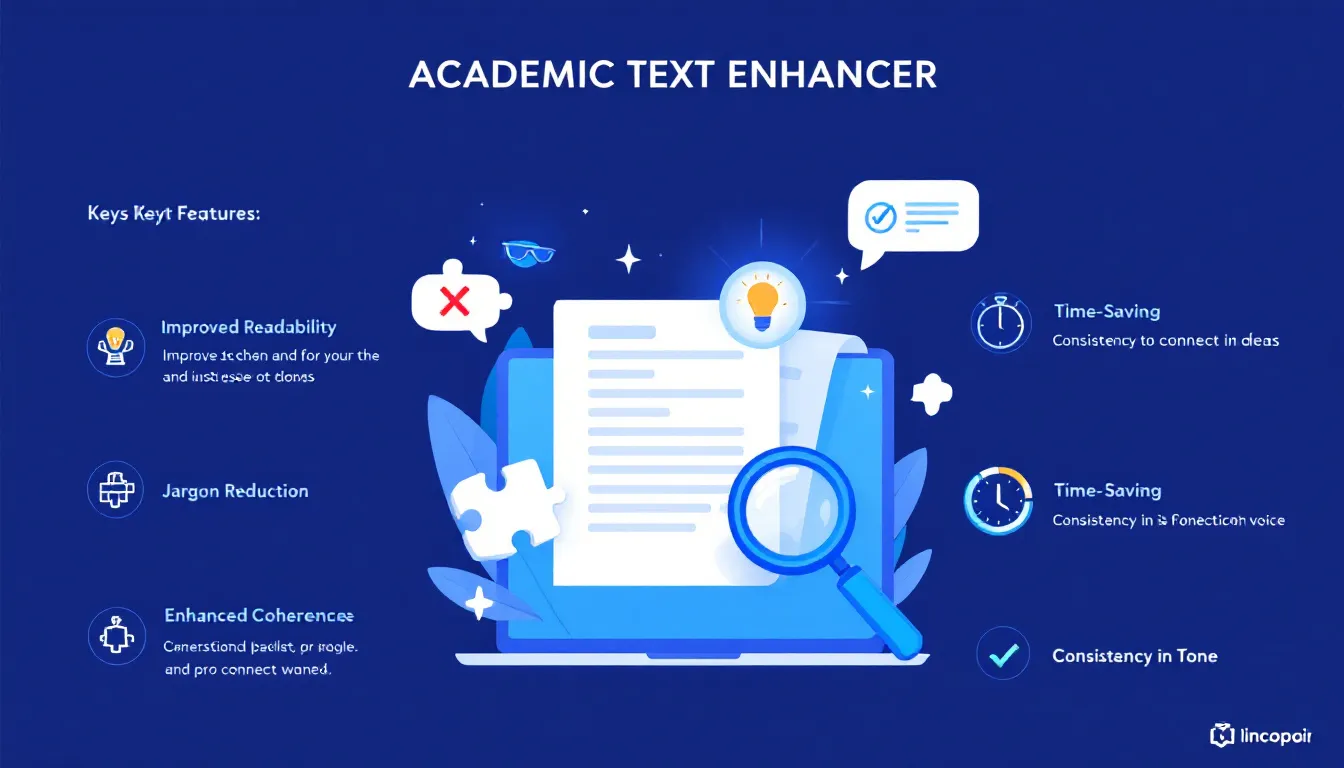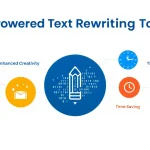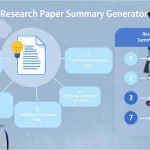Academic Text Enhancer
Is this tool helpful?
How to Use the Academic Text Enhancement Tool Effectively
To make the most of our Academic Text Enhancement Tool, follow these simple steps:
- Enter Your Research Text: In the first text area, paste the piece of text from your research paper that needs review and enhancement. For example, you might input:
“The study’s results indicate a statistically significant correlation between sleep duration and cognitive performance in adolescents, with p < 0.05. Further research is necessary to elucidate the underlying mechanisms.”
- Provide Context (Optional): In the second text area, you can provide brief context about your research paper. This helps ensure the revised text aligns with your overall narrative. For instance:
“This study examines the relationship between sleep patterns and academic performance in high school students aged 14-18.”
- Specify Academic Field (Optional): Enter the specific academic field or discipline of your research paper. This helps in tailoring the language and style appropriately. For example:
“Psychology” or “Cognitive Neuroscience”
- Submit for Enhancement: Click the “Enhance Text” button to process your input.
- Review and Copy: Once processed, review the enhanced text in the results section. If satisfied, use the “Copy to Clipboard” button to easily transfer the improved text to your document.
By following these steps, you can efficiently use our tool to improve the clarity, coherence, and overall quality of your academic writing.
Revolutionizing Academic Writing: The Academic Text Enhancement Tool
In the realm of academic research and writing, clarity and precision are paramount. The Academic Text Enhancement Tool is a cutting-edge solution designed to elevate the quality of scholarly writing across various disciplines. This innovative tool serves as a virtual research expert and copywriter, meticulously reviewing and enhancing the readability of academic texts while preserving their intellectual integrity.
The primary purpose of this tool is to transform complex, jargon-heavy academic prose into clear, concise, and engaging content without compromising on the depth and accuracy of the research. It addresses a common challenge in academia: bridging the gap between expert knowledge and accessible communication.
Key Features and Benefits:
- Improved Readability: The tool refines sentence structure and word choice, making your research more accessible to a broader audience.
- Jargon Reduction: It identifies and simplifies overly technical language, ensuring your work is understandable without losing its academic rigor.
- Enhanced Coherence: By improving the flow of ideas, the tool makes your research more cohesive and easier to follow.
- Preservation of Academic Integrity: While enhancing readability, the tool maintains the essence and authenticity of your original content.
- Time-Saving: It significantly reduces the time spent on editing and refining your text, allowing you to focus more on research and analysis.
- Consistency in Tone: The tool ensures that the revised text aligns with the overall narrative of your research paper, maintaining a consistent academic tone.
By leveraging advanced natural language processing and machine learning algorithms, this tool acts as an invaluable assistant in the academic writing process, helping researchers and scholars communicate their findings more effectively.
The Power of Enhanced Academic Writing
The benefits of using the Academic Text Enhancement Tool extend far beyond simple proofreading or editing. This sophisticated tool offers a range of advantages that can significantly impact the quality and reach of your academic work:
1. Increased Impact and Visibility
By improving the clarity and readability of your research, the tool helps ensure that your work reaches a wider audience. Clear, well-structured academic writing is more likely to be cited, shared, and discussed within the academic community and beyond.
2. Improved Peer Review Outcomes
Clearer, more coherent manuscripts often fare better in the peer review process. By enhancing the quality of your writing, you increase the chances of favorable reviews and successful publication.
3. Enhanced Cross-Disciplinary Communication
In an era of increasing interdisciplinary research, the ability to communicate complex ideas clearly is crucial. This tool helps bridge the gap between different fields by making your work more accessible to researchers outside your immediate specialty.
4. Time and Resource Efficiency
The tool significantly reduces the time spent on editing and refining text. This efficiency allows researchers to focus more on data analysis, experimentation, and developing their ideas, rather than getting bogged down in the minutiae of language refinement.
5. Consistency in Academic Style
Maintaining a consistent academic style throughout a lengthy research paper can be challenging. The tool ensures that your writing maintains a professional and scholarly tone from start to finish.
6. Learning and Skill Development
Regular use of the tool can help researchers improve their own writing skills over time. By observing the enhancements made, users can learn to identify common issues in their writing and develop strategies to avoid them in future work.
Addressing User Needs and Solving Writing Challenges
The Academic Text Enhancement Tool is specifically designed to address a myriad of common challenges faced by researchers, academics, and students in their writing process. Let’s explore how this tool effectively solves these problems:
1. Overcoming Writer’s Block
Many researchers struggle with expressing their ideas clearly, often leading to writer’s block. The tool helps overcome this by providing suggestions for clearer phrasing and more effective sentence structures. For example, it might transform a convoluted sentence like:
“The data obtained from the experiment conducted over a period of six months demonstrated a notable increase in the efficacy of the proposed treatment modality when compared to the control group.”
Into a more concise and clear statement:
“Our six-month study revealed that the proposed treatment was significantly more effective than the control.”
2. Simplifying Complex Concepts
Academic writing often involves explaining complex concepts. The tool excels at breaking down intricate ideas into more digestible forms without losing their essence. For instance:
Original: “The phenomenon of quantum entanglement, wherein two particles become interconnected regardless of the distance between them, defies classical physics and necessitates a paradigm shift in our understanding of reality.”
Enhanced: “Quantum entanglement, where particles remain connected despite distance, challenges traditional physics and requires us to rethink our view of reality.”
3. Improving Flow and Coherence
The tool helps in creating a logical flow of ideas, ensuring that each paragraph connects smoothly to the next. It might suggest transitions or reorganizations to improve coherence. For example:
Original:
“The experiment yielded unexpected results. The control group showed significant improvements. This contradicted our initial hypothesis.”
Enhanced:
“The experiment yielded unexpected results that contradicted our initial hypothesis. Surprisingly, the control group showed significant improvements.”
4. Enhancing Vocabulary and Word Choice
While maintaining the academic tone, the tool suggests more precise or impactful word choices. This can help in avoiding repetition and enhancing the overall quality of the writing. For instance:
Original: “The study looked at the effects of the drug.”
Enhanced: “The study examined the efficacy of the pharmaceutical intervention.”
5. Maintaining Consistency in Tense and Voice
Consistency in tense and voice is crucial in academic writing. The tool helps maintain this consistency throughout the document. For example, it might adjust:
Original: “We have conducted the experiment and analyzed the data. The results will be presented in the next section.”
Enhanced: “We conducted the experiment and analyzed the data. The results are presented in the next section.”
6. Adhering to Academic Style Guidelines
Different disciplines have different style preferences. The tool can adjust the writing to better align with specific academic styles, whether it’s APA, MLA, or Chicago. This includes formatting citations, adjusting punctuation, and ensuring appropriate use of passive or active voice.
Practical Applications and Use Cases
The Academic Text Enhancement Tool finds its application across various scenarios in the academic world. Here are some practical use cases that demonstrate its versatility and value:
1. Dissertation and Thesis Writing
For doctoral candidates and master’s students, writing a dissertation or thesis is a monumental task. The tool can be invaluable in refining chapters, ensuring consistency across the entire document, and making complex theoretical frameworks more accessible to committee members.
Example: A psychology PhD student using the tool to clarify the methodology section of their dissertation on cognitive behavioral therapies in adolescents with anxiety disorders.
2. Journal Article Submissions
Researchers preparing articles for peer-reviewed journals can use the tool to enhance their manuscripts before submission. This can increase the chances of acceptance and reduce the need for extensive revisions.
Example: A team of biologists using the tool to refine their paper on a newly discovered species of deep-sea microorganisms, ensuring that their groundbreaking findings are communicated clearly and effectively.
3. Grant Proposals
When writing grant proposals, clarity and persuasiveness are crucial. The tool can help researchers articulate their project’s significance, methodology, and potential impact more effectively.
Example: An astrophysicist using the tool to enhance a grant proposal for a new telescope design, making the technical aspects more understandable to a diverse grant committee.
4. Conference Paper Preparation
Academics preparing papers for conference presentations can use the tool to ensure their work is concise, clear, and impactful within strict word limits.
Example: A computer scientist using the tool to refine a paper on a new machine learning algorithm, making it more accessible for a mixed audience of specialists and generalists at an AI conference.
5. Literature Reviews
The tool can assist in synthesizing information from multiple sources into a coherent, well-structured literature review, which is often a challenging task for researchers.
Example: A sociology graduate student using the tool to enhance their literature review on the impact of social media on political polarization, ensuring a clear progression of ideas and effective integration of various studies.
6. Interdisciplinary Research Papers
When working on interdisciplinary projects, researchers often need to explain concepts from one field to experts in another. The tool can help in bridging this communication gap.
Example: A team working on a bioengineering project using the tool to make their paper understandable to both biologists and engineers, ensuring effective collaboration and knowledge sharing.
7. Academic Book Chapters
Authors contributing chapters to academic books can use the tool to ensure their writing aligns with the overall tone and style of the book while maintaining their unique voice.
Example: A historian using the tool to refine a chapter on medieval trade routes for a comprehensive book on global economic history, ensuring it complements other chapters while standing out for its clarity and insight.
8. Student Research Papers
Undergraduate and graduate students can benefit from the tool when writing research papers, helping them develop stronger academic writing skills.
Example: An undergraduate chemistry student using the tool to improve their first major research paper on organic synthesis techniques, learning how to structure arguments and present data effectively.
Frequently Asked Questions (FAQ)
1. How does the Academic Text Enhancement Tool improve my writing?
The tool analyzes your text for clarity, coherence, and academic style. It suggests improvements in sentence structure, word choice, and overall flow, helping to make your writing more effective and engaging while maintaining academic rigor.
2. Can this tool be used for all academic disciplines?
Yes, the tool is designed to work across various academic fields. By specifying your discipline in the optional field, you can receive more tailored enhancements that align with the conventions of your specific area of study.
3. Will using this tool affect the originality of my work?
No, the tool does not change the content or ideas of your work. It focuses on improving how your ideas are expressed, ensuring that your original thoughts and research are communicated more effectively.
4. How long does it take to process my text?
Processing time can vary depending on the length and complexity of your text. Typically, you can expect results within a few minutes for standard-length paragraphs or short sections.
5. Can I use this tool for non-English academic writing?
Currently, the tool is optimized for English academic writing. However, we are continuously working on expanding language support for future versions.
6. Is there a limit to how much text I can enhance at once?
The tool is designed to handle substantial amounts of text, suitable for enhancing entire sections or chapters of academic papers. However, for optimal results, we recommend processing your text in manageable segments.
7. How does the tool maintain the academic integrity of my work?
The tool is programmed to preserve the core message and scholarly nature of your text. It enhances readability and clarity without altering your key arguments, data, or findings.
8. Can this tool help with formatting citations and references?
While the primary focus is on enhancing the text’s clarity and style, the tool can identify and suggest improvements for basic citation formats. However, for comprehensive citation management, it’s recommended to use specialized citation software.
9. How often should I use this tool in my writing process?
You can use the tool at various stages of your writing process. It’s particularly useful after completing your first draft and during final revisions. Regular use can help improve your writing skills over time.
10. Is the enhanced text guaranteed to be accepted by academic journals?
While the tool significantly improves the quality of your writing, acceptance by academic journals depends on various factors including content, research quality, and relevance. The tool enhances your chances by improving clarity and readability, but does not guarantee acceptance.
Important Disclaimer
The calculations, results, and content provided by our tools are not guaranteed to be accurate, complete, or reliable. Users are responsible for verifying and interpreting the results. Our content and tools may contain errors, biases, or inconsistencies. We reserve the right to save inputs and outputs from our tools for the purposes of error debugging, bias identification, and performance improvement. External companies providing AI models used in our tools may also save and process data in accordance with their own policies. By using our tools, you consent to this data collection and processing. We reserve the right to limit the usage of our tools based on current usability factors. By using our tools, you acknowledge that you have read, understood, and agreed to this disclaimer. You accept the inherent risks and limitations associated with the use of our tools and services.







